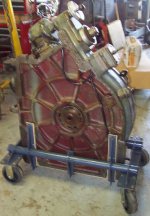Okay, I’m reading your comments, and I did not agree that it is strictly an indexing/positioning table as was commented. That just means I have information that contradicts what was stated.
Here is an example to help clarify what I’m reading about and how they relate to these tables.
Ref:
http://manuals.chudov.com/Pratt-And-Whitney-Co/Jig-Borer-Positioning.pdf
Pg 15 = “the above photos are of an aluminum piece used in a precision instrument, which requires an accurate fit with its component parts. The Pratt & Whitney Jig Borer, equipped with a Rotary Table for indexing, was used to turn the posts, to mill the flat surfaces, and to drill and precision bore the holes in each of the posts. All of these operations were done from the same table set up…….”
So from this bulletin it clearly states that they used these rotary tables in milling operations, this example of milling was rotational. Also on page 18, the description of these particular tables, it states it was designed to be used in any machines not just the jig borer machines outlined in the publication, the 30 & 24” are constructed the same. This includes precision ball bearings and lubricated.
They also differ from that of their smaller manual rotary tables in that those had additional gearing prior to the worm gears to speed them up.
Now in my project, I’m looking at some milling to be done on some specific parts, and am considering setting up a sliding tool post next to the table to take care of some critical cuts; much like a vertical lathe machine would be set up.
So if the design of this rotary table is as such to allow for milling and table was designed to carry a max load of 2200lbs and I can assume they designed it according to the operational needs that would include milling capabilities. I am looking at the reduction of the frictional forces imposed by the max load to about 1/8th and increasing from 12rpms (rated rpms) to 18 rpms while maintaining the same standard SFMs at the cutting tools.
Call it WAG if you want, sure, that’s what I would call it anyway. I was really just looking for some publications regarding this P&W table.
Happy New Year!






